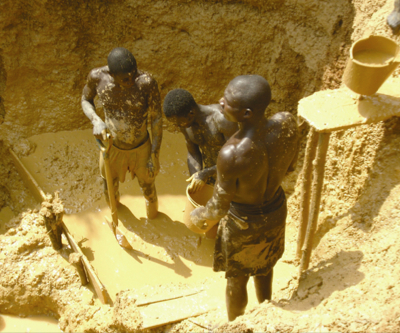
Artisanal mining and small-scale (ASM) — a sector that governments and development agencies often see mainly as a problem — could be a major source of sustainable livelihoods for millions of marginalized people, says a new report released Tuesday by London-based International Institute for Environment and Development (IIED).
In the study, called “Responding to the challenge of artisanal and small-scale mining,” experts identify serious knowledge gaps in the sector, setting out options for a new IIED project-in-the-making.
The goal is to help policymakers ensure small-scale mining helps improve living conditions while taking care of local environments.
“The sector is a paradox,” observes the report. “Productive but undervalued, conspicuous yet overlooked, and ‘small-scale’ but economically and socially significant.”
Statistics published in the document show that small-scale mining produces about 85% of the world’s gemstones and 20% to 25% of all the gold. It also provides jobs and income for 20 to 30 million of the world’s poorest people and supports the livelihoods of five times that number.
Overall, ASM operations employ 10 times more people than large-scale mining. But they take place in very remote areas, usually involve poor and vulnerable people — including women and children — and are renowned for severe pollution and harsh working conditions.
According to the International Labour Organization (ILO), the workforce in small-scale gold mines in Africa is comprised of 30-50% children under 18 years. Due to the poverty, parents even encourage their children to work in the mines so they can buy food and clothes.
Examples like this moved IIED researchers to create a plan that helps connect stakeholders, including miners and their communities, to ensure that better quality information is generated and used effectively in policymaking at local, corporate, national and international levels.
“Small-scale and artisanal mines can be a force for good just as small-scale forestry and agriculture are — but right now they operate in a hidden world,” says Sarah Best of IIED. “We want to identify ways to overcome the challenges — in information, investment and institutions — that prevent small-scale mining from realizing its potential to contribute to sustainable development.”
According to Best, development agencies and national authorities have historically given little attention to the sector and, especially, to how it could be a sustainable activity. Instead they focus on large-scale mining.
As a result governments’ policies are often poorly designed or implemented, or even repressive, while miners themselves lack access to the rights, financial services, market information and technology they need, says the study.
“Most small miners are often driven to operate illegally – and it is this illegality that has biased attitudes about the whole sector,” says the report.
IIED’s new programme of work follows an earlier initiative. In 2000-2002, the institute ran the Mining Minerals and Sustainable Development (MMSD) project, a major review that gathered evidence and engaged stakeholders around the question of how mining and minerals could best contribute to the global transition to sustainable development.
Last year the institute published a 10-year review to assess progress and find the way ahead. ASM was identified as an area where little progress has been made over the past decade.
The new program, say the IIED, will seek to address some of the underlying and ongoing challenges to ensure progress over the next ten years.
Image by CommDev.org